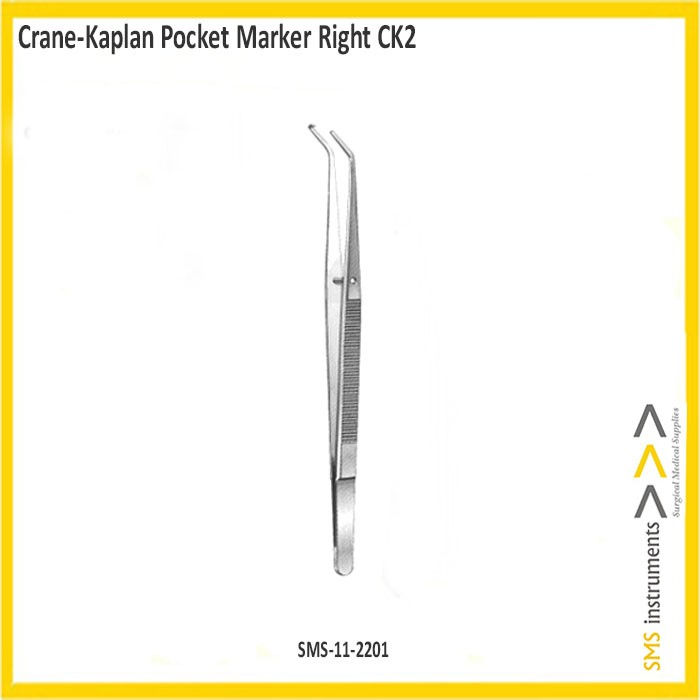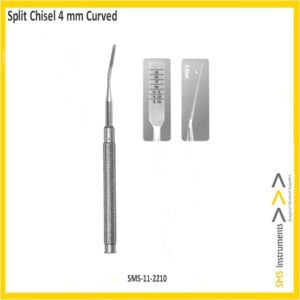Description
Crane-Kaplan Pocket Marker Right CK2
Dental Instruments
SMS Instrument Crane-Kaplan pocket marker right CK 2 is used to determine the depth of soft tissue pockets and the contour of the bone resorption around a tooth.
| Surname | Pocket Marker |
| Tip Configuration | Blunt |
| Size / Model / Figure | CK 2 |
| curvature | Angled Right Side |
| Handle | Cross – Serrated Single – Ended |
| Finishing | Mirror Polish Finishing |
| Instrument Type | Dental Crane Kaplan, Chisels |
| Material | Stainless Steel |
| Disposable or Reusable | Reusable |
| Rusting Prevention | Passivation Processed |
| Cleaning | Ultrasonic Cleaned |
| Sterile or Non-Sterile | Non-Sterile |
| Latex or Latex-Free | Latex-Free |
| Test Performed | Boil, Shape & Performance Test |
| Grade | Premium OR-Grade |
| Packing | Individually Packed in SMS Brand printed Poly-sleeve |
Chisels
Dental chisels designed to shape teeth during the restorative treatment of defects in tooth enamel and dentin. These chisels are typically a handheld, manual instrument with a very small flat blade including a cutting edge that is beveled on one side at the distal end and an integral handle. Dental operative chisels are used mainly to split tooth enamel, to smooth cavity walls, and to sharpen cavity preparations. Cutting edge of the instrument is at a right angle to the axis of the instrument and also Used for the planning or cleaving enamel.
Chisels Edge
This type of finishing line is used after periodontal surgery that result in long clinical crowns termination apically on the tooth structure. If a shoulder and bevel were to be created, and over prepared and probable pulpal exposure are likely.
Feather Edge Finish line
Feather edge or shoulderless crown preparation should be avoided because although they are conservative of tooth structure. They fail to provide adequate bulk at the margins, over contoured restorations often result from feather edge margins, because the technicians can handle the wax pattern without distortion, only by increase its bulk beyond the original contours.
A variation of the feather edge, the chisel edge or knife edge margin is formed when there is a large angle between the axial surfaces and the unprepared tooth.
Chisels Scalers
- The chisel scaler, designed for the proximal surfaces of teeth too closely spaced to permit the use of other scalers.
- It is usually used in the anterior part of the mouth.
- It is a double – ended instrument with a curved shank at one end and a straight shank at the other.
- The chisel is inserted from the facial surface.
- The slight curve of the blade makes it possible to stabilize it against the proximal surface, whereas the cutting edge engages the calculus without nicking the tooth.
- Instrument is activated with a push motion while the side side of the blade is held firmly against the tooth.
Ochsenbein Chisel
- Small delicate bone removal chisel
- Ideal for atraumatic removal of bone adjacent to teeth during crown lengthening
- Used to remove interproximal bone.
- Fine end also useful in elevating fractured root tips
Wedelstaedt Chisel
- It has a slight vertical curvature in its shank
- Mesially and distally beveled
Triangular Chisel
- Blade is triangular in shape with the base away from the shaft
- Has a terminal cutting edge like straight chisel.
Types
Straight Chisel
Mono angled chisel
Bin Angle chisel
Triple angle chisel
Straight Chisel
- The straight chisel has a straight shank and blade, with the bevel on only one side.
- Its primary edge is perpendicular to the axis of the handle.
- Straight and angled chisel are used for splitting off unsupported enamel.
- No bend in shank
- Single beveled / triple beveled
- Minimal accessibility
- Used with push stroke or lateral scraping action.
- They are single planed instruments with five possible cutting movement.
- The cutting edge is one side only, with the bevel of the hand running at a night angle to the shaft.
- Have a straight blade in line with the handle and shank.
Mono angle Chisel
- Blade is shorter as compared to straight chisel.
- Single angle in the shank to enhance convenience form.
- Used with push stroke or lateral scraping action.
Bin Angle chisel
- To angle in the shank.
- Use to cleave or split.
- Undermined enamel.
- Reverse bevel instrument.
- Bin – Angle chisel may have either a distal bevel or a mesial (reverse) bevel.
- Instrument with three cutting motion: vertical, right and left.
Triple Angle Chisel
- Usually used to flatten the pulpal floors.









